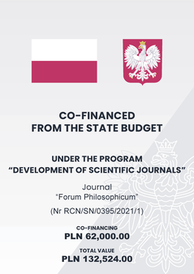O empirycznych przesłankach pluralizmu bytowego
[On Empirical Premises of Ontological Pluralism]
Abstract
The sciences, from their ancient beginnings, use a double way of investigation. One was applied to mineral and astronomical bodies, another to living ones. A ruling, tacit, common sense methodological or epistemological principle was this: The method of description should respect the inner essential properties of the object. For instance, neither the movements of the astronomical bodies, nor the behavior of the living bodies should be described in the scale of subatomic interactions.
In modern times quite another methodological principle has been enthroned. The cosmos, astronomical, mineral and alive bodies altogether, have, allegedly, to be considered as a single natural whole, ruled by essentially the same set of principles. The properties of the mineral world are accepted as a universal model of descriptive concepts, and the explanatory concepts proper to the mineral world are accepted as a universal model of explanation in biology. So, up to now, the academic sciences have been dominated by the philosophical option of materialist monism, or panmaterialism. This option—we may call it antiteleologism and fragmentarism—has a profound impact on empirical research and the way biological phenomena are described. This strange, unnatural, arbitrarily imposed conceptual framework ignores the most fundamental biological dynamisms, and precludes our intellect from seeing the right questions and striving towards the right answers. Consequently it arbitrarily reduces the range of “scientifically acceptable” explanations.
This antiteleological methodology of sciences, imposed on biological mind by philosophers, led to major change in the ideas of philosophers of nature. The physiology and anatomy of the fully developed living bodies has become their central object of study. Much less attention is paid to developmental processes such as biosynthesis, morphogenesis, embryogenesis, phenotypic adaptation and regeneration. The fully shaped structures (biomolecular, cytological or anatomical) and their functional properties are considered a hopeful basis of all the necessary explanations. For instance the structure of tile DNA molecule has become more important than the problem of its origin, and the structure of the brain more important than the developmental processes which lead to its construction.
However, the enormous progress of biological sciences in spite of the widespread, dominating antiteleological and fragmentarist approach corroborates the very ancient, Aristotelian insight, which put the principal stress on the developmental aspect of life. Aristotle, and his more modern followers, was fascinated by the integrated and intrinsically heterogenous tendencies visible in the course of life. Today, we can say that at least eight such tendencies are universal, i.e. appear in every single form of life (starting with bacteria tip to the biology of man):
(a) The tendency to select the proper kind of raw material and the proper kind of raw energy present in the environment.
(b) The tendency to synthesize new, highly selective forms of chemical structures (biological material).
(c) The tendency to utilize biological material in the process of building the nano-, micro-, and macro-machines.
(d) The tendency for a relatively rapid, continuous production and replacement of all the elements of the functional structures of the body (metabolic turnover).
(e) The tendency for a relatively rapid, continuous modification of the functional structures in a way which makes them more efficient within a changing environment (a tendency for phenotypic adaptation).
(f) The tendency to repair and to regenerate the damaged elements of the functional structures of the body.
(g) The tendency for multiplication, which means the production of such structures and the depots of the biological material as seeds, eggs, spores or buds. These structures, providing the environmental conditions are favorable, are starting points of new instances of the above described tendencies.
(h) The tendency—possibly universal—to provide all the structures of the body with the “recognition marks” which help to eliminate all the, “alien” bodies and to recognize members of the own kind.
These tendencies are not homogeneous. Homogeneous tendencies can be illustrated by the tendency of bodies to attract one another. This kind of tendency was the empirical source of such abstract concepts as gravitation, electrostatic force or magnetic force. Biological tendencies are heterogeneous and, at the same time, integrated.
Human intellect is capable of recognizing the fundamental indivisibility (integration) of the set. A great number of observations and experiments have revealed and verified the fundamental indivisibility of the whole set of these tendencies. The concrete, bodily outcomes of these tendencies, however, are quite different in different families and orders of living things. Because of these differences the existence of different kinds of integrative principles was postulated. In this way a plurality of living substances was assumed.
Keywords
- theory of knowledge
- science
- astronomy
- anti-teleologism
- materialistic monism
- minerals
- monism
- ontological pluralism
Cite this article
Lenartowicz, Piotr. “O empirycznych przesłankach pluralizmu bytowego.” Forum Philosophicum 11 (2006): 37–53. doi:10.35765/forphil.2006.1101.3.
Bibliography
Ben-Jacob, Eshel, Israela Becker, Yoash Shapira; and Herbert Levine.“Bacterial linguistic communication and social intelligence.” Trends in Microbiology 12, no. 8 (2004): 366–372. Di Bernardino, Marie A. “Animal Cloning—the Route to New Genomics in Agriculture and Medicine.” Differentiation 68, no. 2–3 (2001): 67–83. Di Bernardino, Marie A. Cloning: Past, Present, and the Exciting Future. In Breakthroughs in Bioscience. The Federation of American Societies for Experimental Biology 1999. http://opa.faseb.org/pdf/cloning.pdf (site discontiued). Dobson Christopher M. “Chemical space and biology.” Nature 432 (2004): 824–828. Klimovich, V. B. “Actual problems of evolutionary immunology.” Journal of Evolutionary Biochemistry and Physiology 38, no. 5 (2002): 562–574. doi:10.1023/A:1022060916099. Koszteyn, Joanna, Piotr Lenartowicz. “Scjentyzm—pozytywy i negatywy.” Zagadnienia Naukoznawstwa 144–145, no. 2–3 (2000): 275–283. Krąpiec, Mieczysław Albert. Psychologia racjonalna. Lublin: Redakcja Wydawnictw Katolickiego Uniwersytetu Lubelskiego, 1996. Lem, Stanisław. Cyberiada. Chotomów: Verba, 1990. Lenartowicz, Piotr. “Totipotencjalność—kluczowe pojęcie biologii rozwoju.” In Nauka—Religia—Dzieje. VI Seminarium Interdyscyplinarne w Castelgandolfo, edited by Jerzy Antoni Janik, 87–118. Cracow: Uniwersytet Jagielloński, 1992. Siwek, Paweł. Psychologia metaphysica. Rome: Pontificia Universitas Gregoriana, 1965. Stout, G. F., and James Mark Baldwin. “Tendency.” In Dictionary of Philosophy and Psychology, edited by James Mark Baldwin, 2:674. New York: MacMillan, 1902. Such, Jan. “Materia.” In Filozofia a nauka, edited by Zdzisław Cackowski et al., 333–340. Wrocław: Ossolineum, 1987.




